
About UsThe Numismatic Bibliomania Society is a non-profit organization promoting numismatic literature. For more information please see our web site at coinbooks.org SubscriptionsThose wishing to become new E-Sylum subscribers (or wishing to Unsubscribe) can go to the following web page link MembershipThere is a membership application available on the web site Membership Application To join, print the application and return it with your check to the address printed on the application. Membership is only $15 to addresses in the U.S., $20 for First Class mail, and $25 elsewhere. For those without web access, write to: David M. Sundman, Secretary/TreasurerNumismatic Bibliomania
Society AsylumFor Asylum mailing address changes and other membership questions, contact David at this email address: dsundman@LittletonCoin.com SubmissionsTo submit items for publication in The E-Sylum, just Reply to this message, or write to the Editor at this address: whomren@coinlibrary.com
BUY THE BOOK BEFORE THE COINYou won't regret it! |
- WAYNE'S WORDS: THE E-SYLUM AUGUST 2, 2009
- LAKE BOOKS 99TH AND 100TH SALES
- LITERATURE DEALERS FANNING AND BURNS UNABLE TO ATTEND ANA
- NBS EVENTS AT THE 2009 AMERICAN NUMISMATIC ASSOCIATION CONVENTION
- WIZARD COIN SUPPLY TO OPERATE ANA MONEYMARKET ENTERPRISE
- NEW BOOK: THE WASHINGTON PATTERN COINAGE OF PETER GETZ
- NEW BOOK: JOHN J. FORD'S 1950S CORRESPONDENCE AND THE "FRANKLIN HOARD"
- NEW BOOK: PROVENANCE: HOW A CON MAN AND A FORGER REWROTE HISTORY OF ART
- NEW BOOK: NEWTON AND THE COUNTERFEITER BY THOMAS LEVENSON
- BOOK REVIEW: COINS OF THE COMSTOCK BY FRED HOLABIRD
- BOOK REVIEW: WEST VIRGINIA MERCHANT TOKENS BY DAVID E. SCHENKMAN
- JUDGE ISSUES RULING ON CONFISCATED 1933 DOUBLE EAGLES
- EDITION M&S NUMISMATIC LITERATURE FROM H. GIETL VERLAG
- PCGS LAUNCHES NEW VERSION OF COINFACTS.COM
- INTERVIEW WITH ART OF MAKING MONEY AUTHOR JASON KERSTEN
- NUMISMATIC RESEARCH IN THE GORHAM COMPANY RECORDS
- MORE ON SETS OF STACK'S JOHN J. FORD COLLECTION, 2003-2007
- A BIOGRAPHY OF U.S. MINT ENGRAVER CHRISTIAN GOBRECHT
- MORE ON COIN WORLD ARTICLES AND COMPLETE SETS
- THE BIG NICKEL MEDAL
- ANSWER: ARE NOBEL PRIZE MEDALS CAST OR STRUCK?
- STILL MORE ON HENRY AND WILLIAM CHRISTENSEN
- JOHN WARD DUNSMORE AND THE AMERICAN WATERCOLOR SOCIETY
- QUERY: ORIGINAL STATE VS. REBINDING
- QUERY: SAINT PATRICK COINAGE IN NORTH CAROLINA
- THE STONEWALL JACKSON MEDAL BY ARMAND AUGUSTE CAQUE
- A PLAQUE OF THE SCULPTURED HEAD OF SAMUEL LACHMAN
- DIX NOONAN WEBB TO SELL ROBINSON S. BROWN JR CONDER COLLECTION
- THE DOLLAR REDE$IGN PROJECT, 2009
- BANKRUPT COIN DEALER NATIONAL GOLD EXCHANGE SHUTS DOWN
- FEATURED WEB SITE: ODESSA MUSEUM OF NUMISMATICS
WAYNE'S WORDS: THE E-SYLUM AUGUST 2, 2009
 Among our recent subscribers is Tony Swicer, courtesy of John and Nancy Wilson, Welcome aboard! We now have 1,238 subscribers.
Among our recent subscribers is Tony Swicer, courtesy of John and Nancy Wilson, Welcome aboard! We now have 1,238 subscribers. If you're having trouble reading the current issue, try the web archive copy: www.coinbooks.org/club_nbs_esylum_v12n31.html
This week's issue has three themes, none of which was planned. First, numismatic literature dealers are dropping like flies and three of them will not be attending the upcoming ANA convention in Los Angeles. The second theme is counterfeiting, in the form of three book announcements. Lastly, we have two new books with saloon tokens on the cover and a reminiscence involving dealer Bill Christensen's favorite watering hole. What is it about numismatists and saloons?
As noted this is a big week for the Numismatic Bibliomania Society - several events are planned for the Los Angeles convention. I can't be there either, but hope everyone has a great time. Please do report back for next week's E-Sylum.
In the news, the big story this week concerns the ten confiscated 1933 double eagles. Other topics include the updated PCGS CoinFacts.com site, St. Patrick coinage in North Carolina, a medal made in Paris to honor a Confederate General, and the Odessa Numismatic Museum.
To learn about Gold Brick Archimedes, a numismatic souvenir of the 1906 San Francisco earthquake and the giant sculptured head of Samuel Lachman, read on. Have a great week, everyone!
Wayne Homren
Numismatic Bibliomania Society
LAKE BOOKS 99TH AND 100TH SALES
 The prices realized list for our sale #99 which closed on July 28, 2009 is now available for viewing on our web site at: http://www.lakebooks.com/archive.html
The prices realized list for our sale #99 which closed on July 28, 2009 is now available for viewing on our web site at: http://www.lakebooks.com/archive.html When you reach that page click on the year "2009" and you will find sale #99 and the two options for viewing the list (PDF or Word).
Our thanks to those who participated in this sale and we are presently cataloguing our 100th sale which will feature selections from the library of J. Roger Persichilli. That sale will have an early October date.
LITERATURE DEALERS FANNING AND BURNS UNABLE TO ATTEND ANA
David Fanning writes:
A 6-page mini-catalogue ("The Briefcase") had been written, describing those items I’d have with me. That catalogue is now posted in Word and PDF format on the David F. Fanning Numismatic Literature Web site at www.fanningbooks.com, and the items are available for sale on a first-come, first-served basis.
Highlights include some very rare early Mint Reports in folio, Dr. Benjamin Rush’s eulogy of David Rittenhouse, and some British government documents relating to counterfeit coppers. Don’t delay in ordering — though please understand that there will be some delay in mailing. Thanks!
NBS EVENTS AT THE 2009 AMERICAN NUMISMATIC ASSOCIATION CONVENTION
It’s that time of year again! The ANA World’s Fair of Money convention will be held this week in Los Angeles. Here’s another look at the planned NBS events. Numismatic Bibliomania Society President John Adams writes:
He will be telling us how he researched the book and brought it to such a successful fruition. The field of colonials has been so heavily researched that adding value to the subject was a special challenge. Dave will be assisted by Dennis Tucker of Whitman.
Other NBS events at the upcoming American Numismatic Association convention are listed on our web site at www.coinbooks.org/events/
NBS Club Table
Aug 5-Aug 9
American Numismatic Association World's Fair of Money
Los Angeles, CA
Manned by Howard A. Daniel III
NBS Board Meeting
Thursday, August 6, 2009
NBS Board Meeting (open to the public)
American Numismatic Association World's Fair of Money
1:00 pm in Room 511A of the
Los Angeles Convention Center, Los Angeles, CA
NBS Numismatic Literature Symposium
Thursday, August 6, 2009
NBS Numismatic Literature Symposium
American Numismatic Association World's Fair of Money
11:30 pm on 8/6 in room 511A of the
Los Angeles Convention Center, Los Angeles, CA.
NBS General Membership Meeting
Friday, August 7, 2009
NBS General Membership Meeting
American Numismatic Association World's Fair of Money
11:30 am on 8/7 in Room 510 of the
Los Angeles Convention Center, Los Angeles, CA
Meeting agenda:
- John Adams introduces the new NBS president -- Dan Hamelberg
- Review the elected board members and vote on three new members to bring the board up to nine.
- New best article award presentation
- New / Old business for the NBS which will include the Secretary/Treasurer's report and any new ideas or information coming out of the board meeting from the previous day.
- Special guest speaker
- Annual Fund-raising Auction
- Closing remarks
WIZARD COIN SUPPLY TO OPERATE ANA MONEYMARKET ENTERPRISE
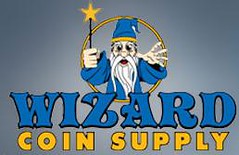 Wizard Coin Supply of Chantilly, Virginia, will take over operations of the American Numismatic Association MoneyMarket, direct mail and online store operations on an interim basis, ANA Executive Director Larry Shepherd announced today.
Wizard Coin Supply of Chantilly, Virginia, will take over operations of the American Numismatic Association MoneyMarket, direct mail and online store operations on an interim basis, ANA Executive Director Larry Shepherd announced today.Under a four-month interim agreement, effective July 15, Wizard will provide customer contact, fulfillment and product handling of all direct mail and online supply and book sales.
The ANA started its MoneyMarket catalog operation in 1986 and later expanded it to include an online store. Due to rising postage and printing costs, however, the ANA would have been required to invest significant amounts of money into software and other resources to stay competitive and, instead, sought an agreement with a company better prepared to efficiently run its direct mail and online store operation.
"We are very pleased that Wizard Coin Supply will take over our MoneyMarket operations," said Shepherd. "For years, our members have purchased numismatic supplies and books through MoneyMarket. We expect Wizard will be able to provide the best-possible customer service and the same – if not better – selection of merchandise. Everyone wins."
Orders can still be placed online at www.money.org/shop at MoneyMarket, which will redirect customers to the Wizard Coin Supply online store at www.WizardCoinSupply.com. ANA members also can continue to call the MoneyMarket number at 1-800—467-5725, which will transfer them to Wizard Coin Supply for sales and customer service.
"We are pleased that the ANA has chosen to work with Wizard," said Wizard owner Wayne Herndon. "We look forward to bringing our expansive product selection, exceptional customer service and competitive pricing to MoneyMarket customers."
To read the complete press release, see: Wizard Coin Supply to Operate ANA MoneyMarket Enterprise (http://www.money.org/AM/Template.cfm?Section=Home
&TEMPLATE=/CM/ContentDisplay.cfm&CONTENTID=14816)
NEW BOOK: THE WASHINGTON PATTERN COINAGE OF PETER GETZ
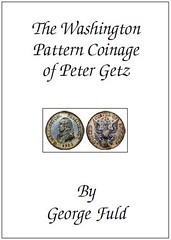 My new book, "The Washington Pattern Coinage of Peter Getz" will be released at the ANA Convention this week. The book lists in detail the known copies of the Silver Getz half-dollar, the Getz 1792 copper "cents" and the related 1797 Getz Masonic medal. Virtually every coin listed is shown in color with detailed pedigrees on each.
My new book, "The Washington Pattern Coinage of Peter Getz" will be released at the ANA Convention this week. The book lists in detail the known copies of the Silver Getz half-dollar, the Getz 1792 copper "cents" and the related 1797 Getz Masonic medal. Virtually every coin listed is shown in color with detailed pedigrees on each.Although estimates of the number known of the Getz issues have been estimated widely, we have been able to trace probably twice as many pieces as previously estimated. We have located 22 different Silver Getz 1792 half-dollars, 55 different Copper 1792 "cents" and 20 different Baker 288 1797 Getz Masonic medals. Early estimates of the number of Getz copper issues were that about 100 were struck. This is obviously quite low as a retention of over fifty percent of a two hundred year old issue is quite improbable. Certainly we have not located all known Getz survivors and would welcome hearing from collectors who might have an unlisted specimen.
Two chapters in the book cover two new aspects of Getz material. There is a thorough discussion of the unique Getz silver large eagle (Baker 23). It is condemned as a non-contemporary production from about 1850.
Also, the new numismatic story of the Washington Ladle is presented. The story behind the 1797 presentation of the buffalo horn ladle by George Washington to Francis Preston is detailed. The ladle had in its bowl a silver specimen of the Getz Masonic medal dated 1797.
The book has two different versions. A soft bound copy and a limited number of hard bound issues are available. There is a prepublication price for copies ordered by October 15, 2009. Books may be ordered from George F. Kolbe, P O Drawer 3100, Crestline, CA 92325-3100.
Special Discounted Price
For orders received by October 15, 2009
❏ Spiral-Bound Edition $75.00 per Copy Postpaid in USA
❏ Cloth-Bound Edition $110.00 per Copy Postpaid in USA
Regular Retail Price
For orders received by October 15, 2010
❏ Spiral-Bound Edition $100.00 per Copy Postpaid in USA
❏ Cloth-Bound Edition $135.00 per Copy Postpaid in USA
California Residents Please Add 8.75% Sales Tax
NEW BOOK: JOHN J. FORD'S 1950S CORRESPONDENCE AND THE "FRANKLIN HOARD"
Hundreds of pages of Ford's letters offer a personal and unique insight into American numismatics. Ford's activities and adventures with tokens, medals, currency, CSA material, numismatic literature, and counterfeits are examined in detail. Then there are the Western Americana items that came from Paul Franklin. In 1952, Franklin sold Ford an 1860 Parsons $20 gold bar. What followed next is a convoluted story. As Ford stated in his 1967 P.N.G. document, "We had a good thing going".
For the first time, the "Franklin Hoard" material, marketed from 1952 to 1981, is classified and listed as such. There is also a comprehensive accounting of what was known and recorded in numismatic channels prior to 1950.
The Ford/Franklin partnership handled dozens of previously unknown pieces, and you will find out who probably made these items, how they were marketed, whom they were sold to, and which ones may have been melted, along with the reasons why.
In-depth research reveals contradictory information from Ford regarding the S.S. Brother Jonathan gold bars, the Bowie Half Eagles, the F.D. Kohler bars, and the recently condemned "Transfer Die Forgeries" of the 1853 U.S.A.O.G. Proof Double Eagles.
Plus, there are over 50 plates (most in color) and many of these pieces have seldom been seen
Pre-publication price is $350 (good until October 1, 2009). Then the price goes to $395.
The book will be hardbound, and limited to just 250 copies. To order, contact the author at numiscats@aol.com
NEW BOOK: PROVENANCE: HOW A CON MAN AND A FORGER REWROTE HISTORY OF ART
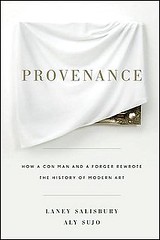 There's another sentiment that can sneak up on you. I was reminded of it while reading Laney Salisbury and Aly Sujo's well-crafted tale of British con artist John Drewe. I'd expected to despise the psychopath at the center of what Scotland Yard called the biggest art fraud of the 20th century. But somehow, from the first page, he got me to drop my guard. Drewe, for all his odious ambitions, is ingenious, persuasive, even brilliant. As I was pulled deeper into his deceptions, I couldn't help admiring this creep.
There's another sentiment that can sneak up on you. I was reminded of it while reading Laney Salisbury and Aly Sujo's well-crafted tale of British con artist John Drewe. I'd expected to despise the psychopath at the center of what Scotland Yard called the biggest art fraud of the 20th century. But somehow, from the first page, he got me to drop my guard. Drewe, for all his odious ambitions, is ingenious, persuasive, even brilliant. As I was pulled deeper into his deceptions, I couldn't help admiring this creep.In "Provenance," Salisbury and Sujo untangle Drewe's elaborate scheme that put more than 200 counterfeit works on the market between 1986 and 1995. What's fascinating about his story is his inventiveness in faking the paintings' provenances. Drewe ginned up receipts for prior purchases; he created catalogs for exhibitions that never took place; he even fabricated records for restoration work that the supposedly decades-old paintings had required over the years. In a master stroke, he smooth-talked his way into the archives of the Tate Gallery, where he inserted some of his phony documents into the files. Experts rummaging about in the archives to certify a work's authenticity would find much to lead them astray.
Drewe could have accomplished none of this without a skilled forger. He found the perfect dupe in John Myatt, a down-on-his-luck artist living alone with his two small kids in a rundown farmhouse in England. For at least £150 each, Myatt was turning out "genuine fakes" -- reproductions clearly sold as such -- of works by Monet, Turner and Matisse. His world changed when Dr. John Drewe phoned him. In an upper-class accent, Drewe told Myatt he was a lecturer in nuclear physics and a consultant to the ministry of defense. He would also claim to others to be a descendant of the earl of York, a historian of the Nazi era, an army lieutenant, a weapons expert and a hang glider. None of it was true. Yet blessed with a prodigious memory, Drewe was able to pose convincingly.
For nearly a decade, the pair faked work by artists such as Alberto Giacometti, Ben Nicholson, Georges Braque and Nicolas de Staël. The fraud was perpetuated by eager salesmen, greedy -- or misguided -- dealers, inattentive auction houses, unwitting art lovers and gullible archivists. It finally unraveled thanks in part to the keen eye and persistence of Mary Lisa Palmer, director of the Giacometti Association. Scotland Yard detectives went to work and brought Drewe and Myatt to trial. In court, Drewe sat impeccably dressed, popping chocolate bonbons into his mouth.
To read the complete article, see: A Connoisseur Who Conned the Art World (http://www.washingtonpost.com/wp-dyn
/content/article/2009/07/24/AR2009072401421.html)
NEW BOOK: NEWTON AND THE COUNTERFEITER BY THOMAS LEVENSON
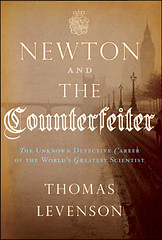 Everyone knows the story about Sir Isaac Newton's run-in with an apple. But when you read Newton and the Counterfeiter by Thomas Levenson, you realize that there was more to the man than an extraordinary understanding of physics and philosophy. The book tells the story of how, in the author's words: "Newton, only months removed from the life of a Cambridge philosopher, managed incredibly swiftly to master every dirty job required of the seventeenth century version of a big-city cop."
Everyone knows the story about Sir Isaac Newton's run-in with an apple. But when you read Newton and the Counterfeiter by Thomas Levenson, you realize that there was more to the man than an extraordinary understanding of physics and philosophy. The book tells the story of how, in the author's words: "Newton, only months removed from the life of a Cambridge philosopher, managed incredibly swiftly to master every dirty job required of the seventeenth century version of a big-city cop."What makes the story spellbinding is not just that Newton managed this transformation, but that in doing so he came up against a criminal mastermind who has few equals -- even in fiction -- for his imaginative brazenness. In 1695 the British government sought out Newton's opinion on troubling financial matters, and although his advice was for the most part disregarded, he ended up being appointed Warden of the English Mint that year.
The greatest mind of the 17th (or arguably any) century found himself in a position to use his superior mental powers to study and rectify the problems of England's Mint. Once he'd improved the manufacture of the King's coin by adding eight new rolling mills and five new coin presses to the Mint, his attention turned to the country's counterfeiters. This is when Newton morphed into a master sleuth, building a network of spies and informers in London's underworld, never hesitating to wade into unsavory, dangerous territory. His mania for detail helped him in matching wits with one of the most inventive criminals of the age, one William Chaloner.
Newton's careful records left Levenson a remarkably clear trail, for being written almost four centuries ago. Adding to the author's storytelling arsenal was an anonymous biography of Chaloner written shortly after his execution in 1698.
Levenson's pace and timing rival those of the best crime story authors. He has written a real page-turner, perfect for a long afternoon's engagement with the hammock or whiling away a long airport layover.
Newton and the Counterfeiter, by Thomas Levenson, Houghton Mifflin Harcourt, Boston, 2009. ISBN: 978-0-151-01278-7. 336 pp. $25.00.
To read the complete article, see: Newton the gumshoe (www.the-scientist.com/blog/display/55860/)
BOOK REVIEW: COINS OF THE COMSTOCK BY FRED HOLABIRD
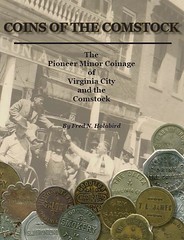 Fred Holabird kindly sent me a printout of his newest book, Coins of the Comstock - The Pioneer Minor Coinage of Virginia City and the Comstock. It's a very readable and well illustrated 90-page book. The tokens and ingots produced by Virginia City, Nevada area merchants are shown in color alongside contemporary black and white photos of the town and its businesses. It has a four-page index listing merchants and topics alphabetically.
Fred Holabird kindly sent me a printout of his newest book, Coins of the Comstock - The Pioneer Minor Coinage of Virginia City and the Comstock. It's a very readable and well illustrated 90-page book. The tokens and ingots produced by Virginia City, Nevada area merchants are shown in color alongside contemporary black and white photos of the town and its businesses. It has a four-page index listing merchants and topics alphabetically.The book's Introduction sets the stage with a short discussion of the Comstock Lode, "one of the greatest and largest ore deposits ever discovered".
This book tells part of the story about the west's need for pocket change, and how people, merchants and the Federal Government adapted to meet those needs. The chapters on Virginia City merchants who used pioneer minor coinage help bring to life the companies and people of the period.
Call me a purist, but I'm in the camp of those who would object to Fred's use of the word "coin" in reference to these pieces. He addresses this choice on page 2:
Regardless of the reader's opinion about the use of the term "token", the book remains a wealth of information about a previously obscure topic. Fred has dug into original source materials such as city directories, contemporary newspapers and historical society photo archives to compile a handy one-stop guide to the history behind the issuers of these rare and interesting souvenirs of the Old West. (There - I wrote "souvenirs", not "tokens", though it pained me to do so...)
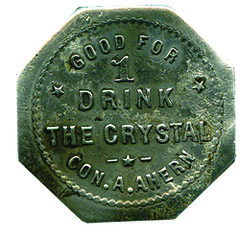 Fred notes that while books exist on tokens from each of the western states, few of them list verifiable dates of issue. In a footnote he mentions Russ Rulau's book United States Trade Tokens, 1700-1900 but notes information on the western pieces was lacking at the time it was printed. His research helps narrow down specific timeframes for the issuance of the tokens, which he divided into pre- and post-1900 periods.
Fred notes that while books exist on tokens from each of the western states, few of them list verifiable dates of issue. In a footnote he mentions Russ Rulau's book United States Trade Tokens, 1700-1900 but notes information on the western pieces was lacking at the time it was printed. His research helps narrow down specific timeframes for the issuance of the tokens, which he divided into pre- and post-1900 periods.Other sections of the book's Introduction introduce the reader to key collecting aspects such as shapes, sizes, denominations, condition and popular collecting areas and categories including saloon tokens, ghost towns, billiards and pool tokens, cigar store tokens, pictorial pieces, Indian trader tokens, military tokens and water tokens.
The remainder of the book is divided into city listings - Virginia City, Gold Hill, Silver City and Jumbo. City listings are further divided as needed into individual businesses and in some cases divided yet again by proprietors of the business. Even in today's Internet age, compiling this information is a lengthy and painstaking process, and the results are neatly displayed here in a Proprietor Chronology for each token.
Some of the illustrations can be hard to read, but this is due to the extreme rarity of some of the pieces - high grade pieces are often unobtainable or just don't exist. In many cases, the only surviving examples were dug from the ground in ghost towns. The Klaus and Sazerac Saloon tokens on page 36 and 37 are typical examples of these. Thankfully I can report that most of the illustrations are quite usable.
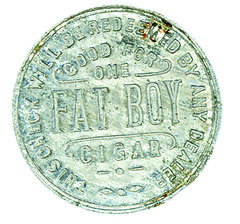 It's easy for those unfamiliar with the series to dismiss these important numismatic items. As is often the case in numismatics, these artifacts are the only tangible record of the existence of the issuing establishment, and most are quite rare today. For example, less than ten examples of the Fat Boy Cigar token are recorded, and the One Shave token illustrated on p70 is unique.
It's easy for those unfamiliar with the series to dismiss these important numismatic items. As is often the case in numismatics, these artifacts are the only tangible record of the existence of the issuing establishment, and most are quite rare today. For example, less than ten examples of the Fat Boy Cigar token are recorded, and the One Shave token illustrated on p70 is unique.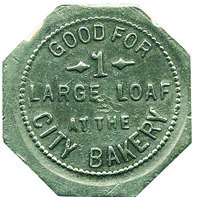 Other than the token vs coin question my quibbles with the book are minor. I noted a few typos (such as "exsists" on p50, "Van Ryzn" instead of "Van Ryzin" in a page 6 footnote, and a stray comma in the name of James King of William on page 79).
Other than the token vs coin question my quibbles with the book are minor. I noted a few typos (such as "exsists" on p50, "Van Ryzn" instead of "Van Ryzin" in a page 6 footnote, and a stray comma in the name of James King of William on page 79). Coins of the Comstock is a well researched and presented book, a nice addition to the literature of American numismatics, and available at an unbeatable price. Fred tells me the book will be available at the ANA in Los Angeles for a special price of $5, or $20 for his Saloon token book together with Coins of the Comstock.
BOOK REVIEW: WEST VIRGINIA MERCHANT TOKENS BY DAVID E. SCHENKMAN
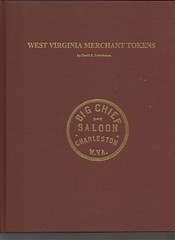 The latest work published by the Token and Medal Society is West Virginia Merchant Tokens by Dave Schenkman. This hefty 500+ page book is bound in maroon cloth.
The latest work published by the Token and Medal Society is West Virginia Merchant Tokens by Dave Schenkman. This hefty 500+ page book is bound in maroon cloth.Based on the collection of the late Jim Thompson, an avid collector of the series, together with the research assistance of Donald Clifford and some forty other West Virginia token enthusiasts, Dave's book fills a long-empty gap in the token book series.
Like the other Token and Medal society volumes, the book catalogs the known merchant tokens of the state, arranged alphabetically by town name. Within towns, tokens are listed alphabetically by company or merchant name. Maintaining consistency is a tough challenge when faced with many tokens that include both a company and merchant name, and many others sporting only initials that may or may not have a known attribution. Regardless, the nineteen page index makes finding a particular token a fairly simple task.
Black and white illustrations are throughout the book, with most pages picturing one or two tokens. No, the tokens aren't ALL illustrated, but even if that weren't a herculean task, picturing them all would expand the book to a multi-volume set.
Also keeping the book to a manageable size is the editorial decision not to include coal mining company tokens, which are catalogued elsewhere. For the same reason, transportation tokens and Civil War store card tokens are excluded as well. The book's focus is merchant trade tokens in use from the end of the Civil War to the 1960s. This approach excludes car wash and parking tokens, wooden nickels and food stamp tokens, since these are of more recent issue.
Congratulations to Dave and the Token and Medal Society for another great publishing effort.
The book lists for is $55 plus $5 shipping. The TAMS member price is $44 plus $5 shipping. Quantity prices are available. Checks should be payable to TAMS and orders sent to:
Mark Lighterman
5224 State Rd. 46, #408
Sanford, FL 32771
Dave Schenkman adds:
THE BOOK BAZARRE
JUDGE ISSUES RULING ON CONFISCATED 1933 DOUBLE EAGLES
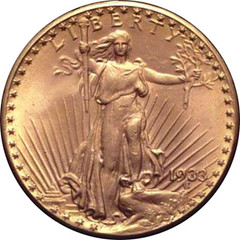 A judge in Philadelphia has ruled that the federal government must return 10 extremely rare gold coins to the family of a late Center City jeweler or outline its case for keeping them in a forfeiture filing.
A judge in Philadelphia has ruled that the federal government must return 10 extremely rare gold coins to the family of a late Center City jeweler or outline its case for keeping them in a forfeiture filing.U.S. District Judge Legrome Davis issued the ruling Tuesday in the case of the 10 1933 "double eagle" gold coins, which experts say could fetch millions at auction. The lawyer representing the family said the coins are thought to be the most valuable gold coins in the world.
The federal government seized the coins in 2004 when the daughter and grandsons of the late jeweler Israel Switt brought them to the U.S. Mint to be authenticated.
Joan Langbord and her sons Roy and David contended in a court filing that the seizure was illegal.
"The Langbord family reserved all their rights to the coin, and the government said it was government property stolen in the 1930s from the U.S. Mint and therefore they had a right to take it," said the family's attorney, Barry Berke.
"The judge said what the government did was a violation of the Fourth and Fifth Amendments," Berke said.
Michael White, a spokesman for the Mint, declined to comment yesterday because the case is still being litigated.
The Landbords' suit noted that in the previous seizure of another 1933 double eagle, the government split the proceeds with the owner after the coin sold for a record $7.59 million at a 2002 auction.
The suit also noted that the government allowed King Farouk of Egypt to own and export a 1933 double eagle in 1944 without questioning how it came into circulation.
To read the complete article, see: Judge says U.S. must return rare coins to Phila. family (http://www.philly.com/inquirer/local/pa/20090801_
Judge_says_U_S__must_return_rare_coins_to_Phila__family.html)
The judge's order released Wednesday calls for the government to initiate a forfeiture hearing by Sept. 28. The hearing would likely amount to a trial in which the government would have to prove Switt's family never legally possessed them, a family lawyer said.
Lawyer Barry Berke argues that some coins could have left the Mint legally through a gold exchange program in place at the time that attracted jewelers like Switt.
"There was a period of time where it was permissible to exchange gold coins for gold bullion," said Berke, who represents Switt's daughter, Joan S. Langbord of Philadelphia, and her sons, Roy Advertisement Langbord of New York City and David Langbord of Virginia Beach, Va.
They say they found the coins in a safe deposit box in 2003, 13 years after Switt died.
To read the complete article, see: US Mint must seek court OK to keep rare 1933 coins (www.mercurynews.com/natbreakingnews/ci_12966509?nclick_check=1)
But we have a particular interest in Berke's sideline in coin litigation. Forgive the shameless self-plugging, but in 2006, we published Double Eagle, a book about the amazing history that culminated in the sale of that 1933 coin. And as we learned in our reporting for that book, Berke is one helluva good coin lawyer.
Further evidence of that talent came on July 28, when Philadelphia federal district court judge Legrome Davis ruled that the U.S. government violated the constitutional rights of Berke's clients, the Langbord family, when it seized 10 1933 Double Eagles that had allegedly been stolen from the U.S. Mint in a heist orchestrated the Langbords' ancestor. Granting Berke's motion for summary judgment, the judge ordered the goverment to initiate a hearing to prove that the coins had been stolen.
The 1940s investigators concluded that all of the Double Eagles that got out of the Mint had passed through the hands of a Philadelphia jeweler named Israel Switt. Though the lead Secret Service investigator pressed for charges to be brought against Switt, the Philadelphia U.S. attorney said the statute of limitations had expired. Switt was never prosecuted for the theft of the coins from the Mint.
In 2005--after the auction of the $7.69 million coin--Switt's daughter and grandson miraculously "found" 10 1933 Double Eagles in a safe deposit box that had belonged to Switt. Switt's grandson, a law school graduate named Roy Langbord, hired Berke to figure out how to keep the coins in the family's possession, even though the government maintained they were contraband that had been stolen from the Mint.
Berke's canny strategy was to turn the coins over to the government, but only for purposes of authentication. Then when the government refused to give the coins back--as Berke surely knew it would--he sued, claiming the coins had been illegally seized from the Langbords. And though assistant U.S. attorneys in Philadelphia argued that the Langbord family had unclean hands, Judge Davis ruled that the Langbords' constitutional protections had been violated. Now the burden of proof lies on the government, which must establish that the Langbord coins were stolen--even though everyone connected with the coins' disappearance from the Mint and the initial investigation of the alleged theft is long dead.
Did we mention that we wrote a book about this case? Double Eagle makes for great beach reading!
To read the complete article, see: Kramer Levin Pulls Off Summary Judgment Against the Government in Million-Dollar Coin Hoard Case (http://www.law.com/jsp/tal/digestTAL.jsp?id=1202432685437
&Kramer_Levin_Pulls_Off_Summary_Judgment_Against_the_Government_in_
MillionDollar_Coin_Hoard_Case)
TEN 1933 DOUBLE EAGLES RECOVERED (www.coinbooks.org/esylum_v08n35a02.html)
IZZY SWITT'S SIEZED 1933 DOUBLE EAGLES ON DISPLAY (www.coinbooks.org/esylum_v09n31a04.html)
SWITT FAMILY SUES MINT FOR RETURN OF 1933 DOUBLE EAGLES (www.coinbooks.org/esylum_v09n50a17.html)
EDITION M&S NUMISMATIC LITERATURE FROM H. GIETL VERLAG

This could be an interesting source for numismatic bibliophiles: H. Gietl Verlag in Regenstauf / Germany has started a new label, Edition M&S, under which they publish smaller editions of very specialized numismatic and collecting topics.
Themes range from Roman numismatics to scrip, bonds, medals (Hamburg, Berlin, France), exonumia, paper money to historical postcards of US city views. Most titles are in German, but this usually does not stop the interested numismatist.
To visit the H. Gietl Verlag web site, see: www.gietl-verlag.de/edition-m-s/verlag/buecher/6.html
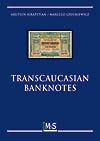
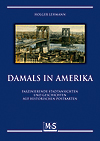
For a publication in English, Airapetian / Gryckiewicz: Transcaucasian Banknotes, see www.gietl-verlag.de/transcaucasian-banknotes/buchdetail/150/verlage/6/neuerscheinung.html .
Of special interest to the US readership might be the book by Holger Lehman which translates Once Upon a Time in America - Fascinating City Views and Stories on Historical Postcards: www.gietl-verlag.de/damals-in-amerika/buchdetail/148/verlage/6/neuerscheinung.html .
PCGS LAUNCHES NEW VERSION OF COINFACTS.COM
Along with dedicated pages for nearly 30,000 U.S. coins, CoinFacts members will have access to the PCGS Population Report, auction prices realized and an expanded price guide – three unique and indispensable tools for determining coin values – free with their membership. In addition to providing basic listings and mintage figures about coin types, users will find an expanded price guide for all coins in all grades; prices realized from all major auctions; survival and rarity estimates for all coins; a condition census for all coins; and relative rarity comparisons for all coins. Coins covered by PCGS CoinFacts content include all regular issue, proof, and commemorative United States Mint coins, and all Colonials, Patterns, and Territorial issues.
"This site will be a tremendous help for the identification and valuation of coins as well as for finding historical information. It will be a tremendous tool for anyone who wants to buy or sell coins," Guth added.
Originally launched in 1999, CoinFacts has expanded for its tenth anniversary to instantly provide an unprecedented amount of online information about U.S. coins ranging from Colonial and Territorial issues to circulation strikes, proofs, patterns and commemoratives. Each coin has its own page that includes photos, detailed information and hyperlinks to other pertinent facts and references.
The updated site also includes digital photographs with enlargement and zoom functions for most U.S. coins, including significant rarities.
"It’s taken years of hard work to create these many enhancements, but the results are extraordinary. And while PCGS CoinFacts has more numismatic information than any other internet resource, it is a work in progress with new information being added daily. I am especially excited about the expert narratives which are starting to appear for many important coins. I believe this will be the first place many collectors, dealers and novices go when they’re looking for specific information or simply want to casually browse the world’s largest online library of numismatic knowledge," said Guth.
The "old" Coinfacts.com site is still available, but it carries a note reading "Warning! This page is no longer updated. Go to the NEW PCGS CoinFacts for updated information." The page also pops up an ad inviting visitors to sign up for the new site.
I'm grateful that the old site is still available. Like many folks I've found it (and the Heritage site) are great resource for coin images when I'm building presentations for young numismatists or illustrating an E-Sylum item (with proper attribution, of course...)
If the owners continue to make the unupdated site available, then those who want occasional free access still have somewhere to go. Like CoinArchives.com, the industry is attempting to transition to a model where a lot of basic information is still made available for free, but advanced features like updated pricing and market intelligence is a paid service.
As I've said before, the market will determine the ultimate price pricing levels, but $9.95 a month seems reasonable for the dealers who use this information in their daily business. Collectors and researchers may have a harder time justifying the cost.
CoinFacts Founder and President Ron Guth is a longtime E-Sylum reader and contributor, so I asked him for his take on the transition. -Editor
Ron Guth writes:
We also include Survival Estimates for all U.S. coins in all grades, MS-60 and better, and MS-65 and better. These are converted into Rarity Ratings which are then used to give Relative Rarity Rankings by Type and Series. We list a Condition Census for all U.S. Coins, including raw and certified examples (this is a favorite project of mine because the results are often surprising and unexpected).
The Auction Prices Realized is a big feature...we aggregate information from the major (and some minor) auction houses and update it as often as monthly. We include commentaries from experts, including personal insights, anecdotes, and special knowledge...basically a brain dump from some of the biggest names in the business.
To view these features, I invite everyone to take the free tour that we offer on our homepage at www.PCGSCoinFacts.com, where we present information on the 1909-S VDB Cent, the 1893-S Morgan Dollar, and the 1875 $10.
However, the biggest difference is this... whereas the old CoinFacts sat idle for nearly five years, the new PCGS CoinFacts benefits from my full-time attention, the support of Collector Universe's phenomenal IT staff, plus the continuing input of many individuals and organizations who have been so generous with their time and knowledge. PCGS CoinFacts is a work-in-progress. Unlike a book, the PCGS CoinFacts website is improved, expanded, updated, and (yes) corrected quickly and easily.
The old CoinFacts will remain available for an indefinite time, where we'll have some annoying ads promoting the new PCGS CoinFacts (understandably, we'd like to recoup some of the significant investment we have made, and will continue to make, in the new site).
Thanks for the opportunity to add to your comments. My hope is that everyone will "Buy the PCGS CoinFacts website before the coin." It's a tremendous value.
For something updated more frequently, you could buy Whitman's Guide Book of United States Coins year after year (as so many of us have done our whole collecting lives). For still more frequent updates on pricing, you could subscribe to the classic weekly dealer Greysheet, a much more expensive proposition.
The new CoinFacts site is updated frequently and stays fresh. The annual cost is more than buying a yearly Redbook, but less than the Greysheet, and includes access to much more information than either, with high-resolution scalable images. How much is that worth to you? -Editor
To visit the new PCGS CoinFacts site, see: www.pcgscoinfacts.com
INTERVIEW WITH ART OF MAKING MONEY AUTHOR JASON KERSTEN
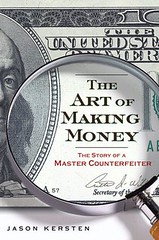 New York City-based writer Jason Kersten is one of the happy breed of scribes lucky enough to turn a Rolling Stone assignment into a book, and may yet prove lucky enough to turn that into a full-length film, as his book has been optioned by Paramount Pictures.
New York City-based writer Jason Kersten is one of the happy breed of scribes lucky enough to turn a Rolling Stone assignment into a book, and may yet prove lucky enough to turn that into a full-length film, as his book has been optioned by Paramount Pictures.For now, however, Kersten's content to talk about what he learned from Art Williams, one of the last of a dying breed of expert counterfeiters and the real-life central character of his book, The Art of Making Money.
Reared in a turbulent family where he was shuttled between an abusive father and mentally unstable mother, Williams' life was irrevocably changed at age 16 upon meeting an expert counterfeiter of U.S. currency bills, and his mother's boyfriend, in a man who dubbed himself "Da Vinci."
But unlike other criminal masterminds who counterfeit for profit alone, Kersten found that both Williams motivation and method of operation were personal, often bordering on ethical. After years spent perfecting a replica of the "1996 New Note" U.S. $100 bill and eventual imprisonment, Williams' criminal quest was more about redeeming and rebuilding a family life lost than "making" money.
To read the complete article, see: On the Money: Writer chronicles the dying breed of counterfeiter (www.sltrib.com/features/ci_12929637)
NUMISMATIC RESEARCH IN THE GORHAM COMPANY RECORDS
Gaining entry to any archives requires advance application - contact with a director or staff member, providing a list of credentials, a statement of purpose and a little of your previous experience. I have boiled this all down to about five paragraphs, and even with that I only state some of the highpoints. For example, I have researched in dozens of libraries, archives and company records, but only listed four in my initial contact. I end with a boilerplate stock ending of my numismatic activity and recent accomplishments.
Even with that I bring with me a card wallet of membership cards and such in numismatic organizations, photocopy debit cards from some of the top research institutions (Library of Congress, U.S. Patent Office., others) The oldest card is from 1954 when I researched with Walter Breen at the National Archives in Washington DC (and I brought in one of the world's first portable photocopy machines) to copy Mint documents).
On arrival all institutions now want a picture ID. A driver's license will do. This was the first institution in my experience that kept the card while you are in the building. All others were satisfied with photocopying the card and returned it immediately.
A manuscript department assistant usually has a conversation with you at this time. Here again you have to state what you are seeking and a little of your previous research experience. I also toss out my wallet of numismatic credentials. If you have properly impressed the assistant he (or she) usually forgoes examining the contents of that wallet. But I have had some who looked at every card.
The first half of the day proved futile. One journal of Gorham customers -- which could possibly have given us our answer -- was missing the two pages for the 1907-1908 time period we wanted to view. Bad luck. Then our luck changed full circle.
Sam Hough walked up to our table. He was the one who saved the Gorham records from destruction. He gave us a little of the background. Textron purchased Gorham Company and the usual new management decision came down: destroy all the old records. A Gorham insider tipped off Sam, at that time a rare book librarian at Brown's John Hay Library. Sam rushed over to find some of the records already in the dumpster.
To shorten the story, he gathered three truck loads of Gorham records. The contents of those truck loads were weighed; nine tons of records were saved from destruction! He next spent 9 months organizing them, and writing a summary of their contents. We were handed his 2-volume "Finding Guide" when we first entered the reading room. He accomplished this hercularian task in record time (and has even given speeches to groups of professional archivists on how he did this).
Then Sam started bringing in boxes and drawers of records for us to examine -- and blowing our minds! I had brought with me a record of 103 medals made by Gorham. In one drawer alone was a photo file of 438 medals (and similar items) made by Gorham, each with a 4 or 5-line photo caption right on the photo.
With the next armload, he teased us, "Got to entertain you fellas." We were more than amazed, or entertained! We were overwhelmed! After a far too-brief a time examining this latest trove we had to stop. We had to get our photocopy orders in as it was approaching an hour before closing time. I learned long ago, never wait to the last minute to have staff do your photocopying. I can't wait to return.
MORE ON SETS OF STACK'S JOHN J. FORD COLLECTION, 2003-2007
George Kolbe writes:
In my opinion, the price for complete softbound Ford sets is likely to drop over time as more and more sets enter the secondary market. Initially, four part sets of Bowers' Garrett Collection easily brought $75 or more; hardbound sets $150 or more.
I do not think, however, that the analogy will hold true for hardbound Ford sets since the special edition Garrett catalogues were bargain-priced and aggressively marketed while their Ford Collection counterparts were higher priced and less actively promoted.
I have no idea of edition runs of either hardbound version but "4-5 sets bound in grey leather (sic)" appears to be too low.
George Cuhaj writes:
For some of the sales, like Lovejoy, I only remember ordering 5-6 white leather for Lovejoy family members and the company library. For other sales, like Halpern and Hawn, there were regular soft back catalogs, Hard Back Catalogs with the Prices Realized added in a hand tipped in envelope (distributed to bidders after the sale, with a numbered bookplate); and then Cloth Hard back (usually under 30), and leather hard back (usually under 10). I am sure collectors will see plenty of interesting stuff in the forthcoming sales of the (Company/Family) Library.
To read the earlier E-Sylum Ford article, see: ON BOUND SETS OF STACK'S JOHN J. FORD COLLECTION, 2003-2007 (www.coinbooks.org/esylum_v12n30a09.html)
On a separate topic, George Kolbe adds:
To read the earlier E-Sylum Adams article, see: ON THE ADAMS U.S. AUCTION CATALOGS BOOK REPRINT (www.coinbooks.org/esylum_v12n30a05.html)
A BIOGRAPHY OF U.S. MINT ENGRAVER CHRISTIAN GOBRECHT

In the Gobrecht Journal, issue #101, I related the story of Charles Gobrecht Darrach (a grandson of Christian Gobrecht) and his research into his grandfather's work. Darrach published, in 1906, a biography of his grandfather, in the Pennsylvania Magazine of History of Biography. Another version of this biography appeared in the Numismatist, in 1911, and was unsigned. I speculated that Darrach was the author of both pieces, as there was some similarity between the two. A cryptic voicemail message has now served to unravel the puzzle.
On July 27th, my wife left me a note regarding a voice mail received from "Tony Turnover" regarding a "Gold Brick Archimedes." After much thought, I concluded that the message was from Tony Terranova, a well known dealer in early Americana, medals, and anything that he finds "interesting." As for the "gold brick Archimedes," I felt that this might be an specimen of Gobrecht's Archimedes medal (Julian AM-55) in gold. The Archimedes medal engraved by Gobrecht and issued by the New England Society for Promotion of Manufacturers and Mechanics in 1828, was unknown to me in gold.
Now, Mr. Terranova tends to know the full history on anything in his inventory, so it is good to do one's research before doing any negotiating. I jumped onto the Internet to find out what I could about this gold medal.
Along the way, I stumbled onto Google books and looked over "The Lives of Eminent Philadelphians," by Henry Simpson. The 1859 book contains a character sketch not only of Christian Gobrecht, but of many individuals connected with the early days of the Philadelphia Mint, including David Rittenhouse, Elias Boudinot, Robert Patterson & others. The full text of Simpson's book is available on Google books at: http://books.google.com/books?id=eHkFAAAAQAAJ&
printsec=frontcover&dq=the+lives+of+eminent+philadelphians
The Gobrecht biography looked familiar, and a quick glance at the 1911 Numismatist revealed that the two pieces were identical. Thus, we can now credit Henry Simpson with the earliest Gobrecht biography, written 15 years after Gobrecht's death in 1844.
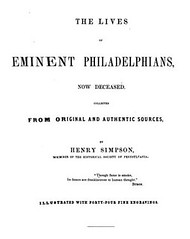 At an early age, Mr. Christian Gobrecht exhibited great mechanical ability, and evinced a taste for drawing and design; he was consequently apprenticed to a clockmaker living at Manheira, Lancaster County. His master, however, dying a short time after, he was released from his indenture, and, removing to Baltimore, pursued the course evidently marked out for him, guided by no other teacher but himself.
At an early age, Mr. Christian Gobrecht exhibited great mechanical ability, and evinced a taste for drawing and design; he was consequently apprenticed to a clockmaker living at Manheira, Lancaster County. His master, however, dying a short time after, he was released from his indenture, and, removing to Baltimore, pursued the course evidently marked out for him, guided by no other teacher but himself.About the year 1811, Mr. Gobrecht removed permanently to Philadelphia, where his principal pursuit was that of a bank note writing engraver; he, however, as opportunities offered, engraved seals, calico printers' rolls, bookbinders' dies for embossing morocco, dies for striking brass ornaments for military equipments, and also executed several medals. In 1836, in consequence of the contemplated change in the devices on the American coin, he was appointed Die-sinker in the United States Mint, which office he filled until his death...
In addition to his skill as engraver, Mr. Gobrecht was no less ingenious in other branches. Although no performer on any instrument he was a scientific musician, and constructed two musical instruments on the principle of the melodeon, but long before that instrument was thought of. He also devised a speaking doll, about the time Maelze's puppets were exciting attention. A camera-lucida with steel mirrors, by which one part of the eye received, by reflection, the impression of the object, and another part the direct impression of the pencil and paper beneath, without the interposition of any foreign medium, was constructed by him, and is a neat and useful instrument.
MORE ON COIN WORLD ARTICLES AND COMPLETE SETS
Len Augsburger writes:Mark Borckardt writes:
Local auctioneer Steve Scofield of Centennial Auctions listed them by year in one of his sales, and received bids for some of the earlier years that were sent out to the successful bidders. The balance went to the recycling plant.
George Kolbe writes:
The stacks moved ever so slightly as I entered the room, or perhaps I imagined that. Two walls of the bedroom were lined with overflowing bookcases and a number of cardboard cartons of books and catalogues were on the bed (Jack stacked these at night on the floor before going to sleep).
Shrouded in plastic in a small clothes closet was the toreador outfit worn by Cantinflas in Around the World in Eighty Days. A relative of Jack's was in the movie business and gave it to Jack. For several years, Jack was an assistant Hollywood producer, involved in Sonny & Cher specials, Laugh-In episodes, etc. In earlier years he owned a beer bar and also owned an upscale coin shop in the early 70s.
On a later visit, the Coin Worlds were gone; I do not recall what he did with them.
Bruce Smith writes:
I do want to make two points. First, about 1975 Coin World became available on microfilm. You could buy the set on microfilm, but in order to do so, you had to have current subscription. I decided at that time that I would eventually but the set on microfilm. Unfortunately, I never did and I don't know whether it is still available for sale.
Second, there is an index to Coin World -- or at least, there was. In the 1980's I wrote to Coin World asking if they could list any articles on Missouri tokens which had appeared in their publication. To my surprise, they sent pages and pages, xeroxed from some master list they were keeping internally. So, it is possible that Coin World still has an internal index, and perhaps someone could persuade them to make it available --- perhaps by donating a copy to the ANA Library.
I do, however, maintain files of World Coin News and Bank Note Reporter, both of which began as tabloid size newspapers. I worked for World Coin News during 1975-1977, and have a complete set from Volume 1 #0 (which came before Vol. 1 #1). The first few years I had hardbound -- back when it was affordable to do so. I also have nearly a full set of Bank Note Reporter.
Because I moved several times (including a year in China), a few issues of BNR and perhaps WCN went astray. Last month I unpacked and sorted all the back issues of WCN and BNR. The current size of these periodicals fits nicely in the one foot square fold-up boxes sold by the OfficeMax chain. The Swedish department store chain, Ikea, sells a fold-up box which is just right for storing letter size magazines like Numismatist, TAMS Journal, and Paper Money magazine.
Unfortunately, I haven't found a box which holds tabloid-size publications efficiently. Currently I have my tabloids in fold-up boxes which are about 6 inches too long. There is probably some specialty company which makes boxes to hold tabloid-size publications, but I haven't found it yet. Any suggestions?
To read the earlier E-Sylum article, see: MORE ON COMPLETE SETS OF COIN WORLD (http://www.coinbooks.org/esylum_v12n30a10.html)
THE BIG NICKEL MEDAL
In last week's article about the anniversary of Sudbury, Canada's "Big Nickel" sculpture, Dick Johnson wrote:Tom DeLorey writes:
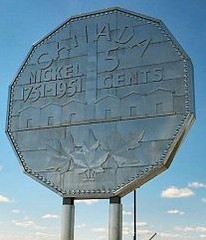
I visited the Big Nickel park back in 1978 while on vacation with my father. We were driving around Lake Huron, and I figured I might never be in Sudbury again. I was right. There was an affiliated attraction where for a few dollars you could ride a gondola down the shaft of a nickel mine. I don't know if it is still open.
To read the earlier E-Sylum article, see: CANADA'S BIG NICKEL CELEBRATES AN ANNIVERSARY (http://www.coinbooks.org/esylum_v12n30a22.html)
ANSWER: ARE NOBEL PRIZE MEDALS CAST OR STRUCK?
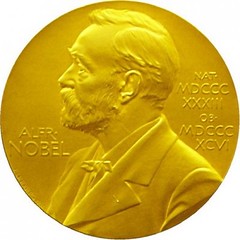 Last week Kerry Rodgers asked
Last week Kerry Rodgers asked Jim Duncan writes:
Ira Rezak writes:
To read the earlier E-Sylum article, see: QUERY: ARE NOBEL PRIZE MEDALS CAST OR STRUCK? (http://www.coinbooks.org/esylum_v12n30a19.html)
THE BOOK BAZARRE
STILL MORE ON HENRY AND WILLIAM CHRISTENSEN
Jeffery Zarit writes:
George Kolbe writes:
I am disappointed that one of last week's correspondents, in a veiled tribute to Henry Christensen, took the opportunity to grind once more a very old axe.
Howard A Daniel III writes:
Over the years it went up with my pay until my last allowance was $200 per month and then we took off my limits when our savings and investments hit a particular point, but I was not supposed to break the bank. Right after my "no allowance" was started, I was offered many excellent items I needed in one group for $10,000, but I talked the seller down to $5,000 to my wife's great relief.
With my specialty covering Southeast Asia, Henry and William Christensen were one of my few sources in the 1970s. When I first wrote to the Christensens, I asked them to add me to their mailing list. When I saw they had many items of interest to me, I wrote to them again and asked if I could please pay them monthly for my purchases. I received an immediate "yes" and they really did not know me from Adam. My $15 per month to them went on for several years.
When I received something from them, I accessioned it into my logbook and printed "HC" and the cost on the 2x2 or note holder. Looking through my Sarawak, Borneo, Malaya, Brunei, Singapore and other pieces, there are many HC's on the holders. I am sure there are dealers today who will allow payments but likely only after a credit or background check. Within a few years after being back in the USA, there were many other dealers who also allowed me to pay them monthly, so my budget rarely had any "free" money. With such a tight budget, I had to carefully evaluate every piece purchased to make sure I got "good" stuff for my collection. Looking back over those purchases, those pieces are the most valuable in my collections based on current rarities and values. Budgeting was good for me!
Fred Schwan writes:
A friend and I were involved with some transactions will Bill. In spite of the passage of several years and great attempts, Bill did not resolve the matter nor communicate with us about it. The communication was the worst part.
Eventually, the friend and I stopped in Madison, NJ during a road trip that we were on. I do not know what we thought, but Bill was not easy to find. The business address had been a post office box for a very long time. Madison is a charming town. We started by having breakfast in a diner and studying the phone book. No luck there.
I went to the post office. In a casual chat, an employee told me that he did still come in once in awhile to empty his box. Good news, but not great unless I wanted to have a month long stake out. We tried the Internet (not nearly as useful then as now) and made cold inquiries in various establishments that I thought he might frequent.
Finally, we got a great break. A merchant mentioned that there was a coin shop in town. It had not been in the phone book that I had studied earlier. The coin shop was interesting. My associate and I bought a few things, and the proprietor told us where the Christensen offices were. Bing. By this time it was shortly before noon.
The building showed no sign of occupancy by the Christensen firm, but the fellow at the coin shop had said that the office was upstairs so up the stairs we went. Half way up the stairs, Bill came around the corner to go down the stairs. Momentarily he was surprised (shocked), but responded quickly and invited us to go to lunch with him.
He led us to a tavern just half a block away. The bartender and server obviously knew Bill. The three of us, actually the five of us spent the afternoon there. If there were any more customers, I do not remember it. Mostly we talked sports, but talked a little bit of numismatics. We did not discuss the errant deal.
When I returned to the table after a two minute necessity break, Bill and my friend had their coats on, were standing, and clearly ready to depart. One or the other said that they had worked out the details of our deal! Wow. This must say something about me, but it was good news.
We went back to the Christensen offices, and this is the very best part of the story. The office was a maze and a treasure warehouse. We spent the balance of the afternoon and early evening there. Bill showed us several of his collections and we looked at some old inventory and literature--lots of literature. He had a nice library of books, but what he had in great quantity were auction catalogs. Tons--literally.
Bill gave us the required documents and we continued on our trip. Well, it did not work out--again.
Fast forward a few years. My friend and I are in Madison again. The Christensen office seems to be closed. The tavern had the same bartender, but he stated that he did not know who Bill Christen was. We ordered lunch and waited. As anticipated, Bill came in shortly before noon. He had that same look of surprise and the same fast recovery. Again we talked sports for hours.
Eventually, we went to the office again. Bill told us that he was planning a move to smaller offices. One of the problems was the aforementioned auction catalogs. I put him in touch with a well-known literature dealer who wound up buying the catalogs. That dealer later told me a good story about buying the catalogs. It involves the same tavern. Hopefully, he will jump in and tell that story (hint, hint). Possibly he even still has some of the catalogs.
Back to the office. Once again, Bill gave us material to resolve our problem. This time it worked out. Unfortunately, I never saw (or communicated with) Bill again.
JOHN WARD DUNSMORE AND THE AMERICAN WATERCOLOR SOCIETY
Regarding the American Watercolor Society, Len Augsburger writes: John Ward Dunsmore served for a time as the President of the Society and also presented in their annual exhibitions. Dunsmore is of course known to numismatists as the painter of "Washington Inspecting the First Money Coined by the United States." The Society is still active and has a library in Manhattan - it's been on my to-do list and I will certainly keep a look out for the medals. I do not believe that the Society ever issued a medal to Dunsmore, as such a medal is unmentioned in his biographical papers, while other medals are.
John Ward Dunsmore served for a time as the President of the Society and also presented in their annual exhibitions. Dunsmore is of course known to numismatists as the painter of "Washington Inspecting the First Money Coined by the United States." The Society is still active and has a library in Manhattan - it's been on my to-do list and I will certainly keep a look out for the medals. I do not believe that the Society ever issued a medal to Dunsmore, as such a medal is unmentioned in his biographical papers, while other medals are. To read the earlier E-Sylum article, see: THE AMERICAN WATERCOLOR SOCIETY AWARD MEDAL (http://www.coinbooks.org/esylum_v12n30a23.html)
QUERY: ORIGINAL STATE VS. REBINDING

The decision to rebind (with 3/4 leather & marbled paper) was made so that the works could be consulted without additional damage to the contents; yet, the loss of the original bindings means that the books no longer exist as totally original documents. The intent of the authors/publishers now exist only as photographs. Is rebinding/restoration a detriment or an asset to maintaining the record of our numismatic literary heritage? A photo of the Baker binding is attached.
QUERY: SAINT PATRICK COINAGE IN NORTH CAROLINA
Mark Borckardt writes:The rumored finds in North Carolina interest me from a genealogical standpoint. My seventh great-grandparents and their families relocated from Western New Jersey (Hopewell area) to central North Carolina (north of Charlotte) in the early 1700s.
THE BOOK BAZARRE
THE STONEWALL JACKSON MEDAL BY ARMAND AUGUSTE CAQUE
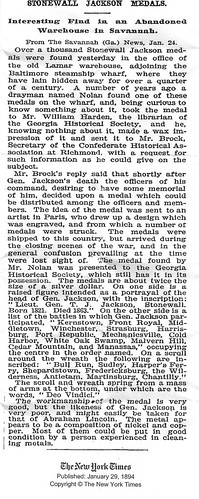 I read in last week's E-sylum where Harold Levi and George Corell were looking for some assistance with finding Confederate coins minted in Paris between 1861-1865. Towards this goal I can not help, but if they want some evidence that the Paris mint issued a Confederate medal I can assist them.
I read in last week's E-sylum where Harold Levi and George Corell were looking for some assistance with finding Confederate coins minted in Paris between 1861-1865. Towards this goal I can not help, but if they want some evidence that the Paris mint issued a Confederate medal I can assist them.After General Thomas J. "Stonewall" Jackson's death the Confederacy ordered a medal made in his honor.( According to an article in the N.Y.Times, January 29, 1894, his officers under his command decided to memorialize their leader with a medal).
Armand Auguste Caque (1793-1881) was the engraver of the Stonewall Jackson medal. According to Forrer, Vol.I, p.204-206, Caque was a French medalist, born at Saintes; he was a pupil of the Royal School at Rochefort, the Ecole d'application at Metz, and of Raymond Gayrard. From 1817-1818, he was employed as Assistant-engraver at the Mint of the Hague. Under Napoleon III, he was appointed Engraver to the Imperial Cabinet, a post which he held from 1853-1868. He died in Paris in December, 1881.
There is no mention in Forrer of this particular medal or any Confederate coins either, yet Caque is the engraver of the Jackson medal. His name is below the General's truncation on the obverse, CAQUE F.
The obverse of the medal has a very poor likeness of Gen. Jackson, Caque had never met the man, the legend surrounding the rim reads: "LIEUT.GENERAL T.J.JACKSON "STONEWALL" BORN 1821-DIED 1863". The reverse lists the battles the General participated in, and on a scroll around a wreath are some of the South's major victories. The scroll and wreath spring from a mass of arms at the bottom, under which are the words "DEO VINDICI". The medal is white metal (pewter?), 2", without any edge markings and it was probably made around 1864.
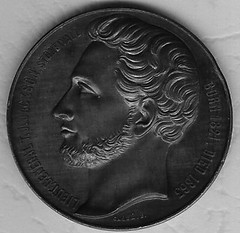

The story in the N.Y. Times only gives a small part of the events leading up to the discovery of these medals. It does not go into the details of how these medals had to run the Union blockades to enter the Port of Wilmington, NC and then were transported to a warehouse in Savannah,GA. during the "closing scenes" of the war and lost for sixty years seating in a warehouse. That in itself is an amazing storyline.
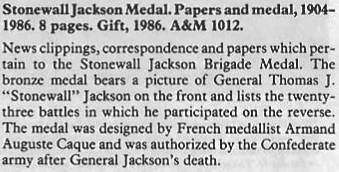
To view the complete West Virginia University Library newsletter, see: West Virginia and Regional History Collection Newsletter v2n3 (http://www.libraries.wvu.edu/wvcollection/
newsletter/1985-1994/v2n3.pdf)
A PLAQUE OF THE SCULPTURED HEAD OF SAMUEL LACHMAN
Ira Rezak writes:Yet now, in the back of a showcase within a nondescript shop, the type that offers used costume jewelry and bric-a-brac rather than antiques worthy of the name, my eye fell upon something brown and metallic. I ended up buying it, a decision that has rewarded me with an adventure of research and discovery. It was a uniface plaque, six inches by eight, fairly heavy, bearing a scene of devastation.
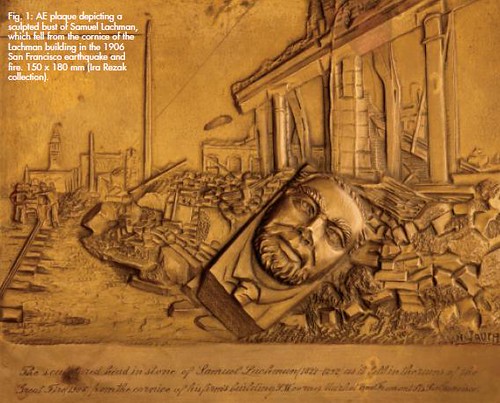
The inscription read: "The sculptured head in stone of Samuel Lachman (1824–1892) as it fell in the ruins of the Great Fire (1906) from the cornice of his firm’s building S.W. corner Market and Fremont Sts. San Francisco." The plaque also bore a clear artist’s signature: H. JAUCHEN.
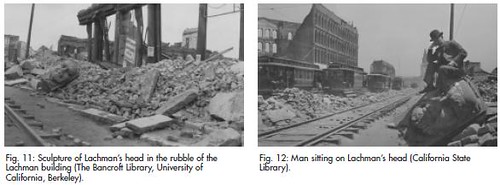
To read the complete ANS Magazine article, see: Ozymandias in San Francisco: A Medallic Memorial of the Great Earthquake and Fire of 1906 (http://ansmagazine.com/Winter06/Ozymandias)
DIX NOONAN WEBB TO SELL ROBINSON S. BROWN JR CONDER COLLECTION
Back in February 2006, Peter Koch asked:Well, we don't always get answers to questions posed in The E-Sylum, but good things come to those who wait. Cataloguer Peter Preston-Morley of Dix Noonan Webb writes:
 The London, England, auction house of Dix Noonan Webb will be selling the collection of Conder tokens formed by the late Robinson S. Brown Jr in four parts, beginning October 7th 2009 (Bedfordshire thru Lincolnshire). Subsequent auctions are scheduled for October 2010 (Middlesex), October 2011 (Norfolk thru Yorkshire) and October 2012 (Wales, Scotland, Ireland and an extensive run of duplicates). Catalogues may be had from Dix Noonan Webb, 16 Bolton Street, London W1J 8BQ, England, www.dixnoonanwebb.com or www.dnw.co.uk.
The London, England, auction house of Dix Noonan Webb will be selling the collection of Conder tokens formed by the late Robinson S. Brown Jr in four parts, beginning October 7th 2009 (Bedfordshire thru Lincolnshire). Subsequent auctions are scheduled for October 2010 (Middlesex), October 2011 (Norfolk thru Yorkshire) and October 2012 (Wales, Scotland, Ireland and an extensive run of duplicates). Catalogues may be had from Dix Noonan Webb, 16 Bolton Street, London W1J 8BQ, England, www.dixnoonanwebb.com or www.dnw.co.uk. To read more about my visit with Peter, see: WAYNE'S LONDON DIARY 15 JULY, 2007 (www.coinbooks.org/esylum_v10n28a16.html)
To read the complete E-Sylum query, see: ROBINSON S. BROWN CONDER TOKEN COLLECTION INFO SOUGHT (www.coinbooks.org/esylum_v09n08a22.html)
THE DOLLAR REDE$IGN PROJECT, 2009
From The Atlantic:
To read the complete Atlantic article, see: Currency Exchange (http://www.theatlantic.com/doc/print/200906u/currency)
From Allison Arieff's July 19, 2009 New York Times blog:
Charmed by the graphic perfection of Switzerland’s currency and the elephants and rhinos bursting forth from South Africa’s, Bierut thinks it’s time for a currency overhaul in this country. He points to the grassroots efforts of creative consultant Richard Smith, whose recent Dollar ReDe$ign project invited anyone to submit an idea. "The only realistic way for a swift economic recovery," Smith proposes, "is through a thorough, in-depth rebranding scheme — starting with the redesign of the iconic U.S. dollar."
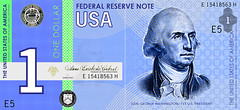
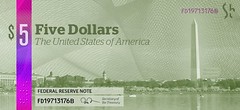
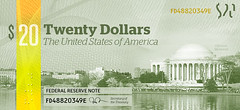
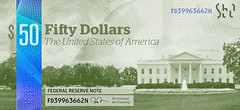
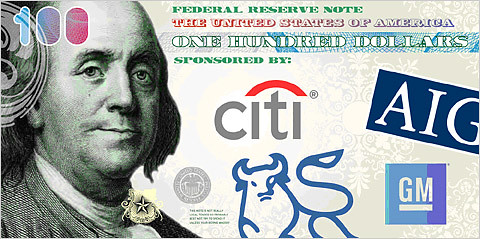
BANKRUPT COIN DEALER NATIONAL GOLD EXCHANGE SHUTS DOWN
Thirty years later, National Gold Exchange, one of the world's largest coin wholesalers, is battling for survival with more than $50 million in debts.
On Friday the Tampa company filed for Chapter 11 bankruptcy. It happened after Boston's Sovereign Bank, NGE's largest creditor, called a $35 million business loan to the Yaffes earlier in the week.
Sovereign officials arrived last week at NGE's office on North Dale Mabry Highway to remove millions of dollars worth of coins pledged as collateral for the loan.
"We basically didn't have a choice with the bank debts and the other debts that are owed," said NGE lawyer Daniel Saxe. "The plan would be to see if the company can reorganize and come out with a clean start.''
Rumors that NGE had fallen on hard times have swirled around the coin business the past year. Several business associates in Colorado sued the company for unpaid debts in 2008. In May, Sovereign Bank said it discovered NGE was floating bad checks after exhausting its $35 million line of credit with the lender.
Still, since the teenage Yaffes opened a coin stall in a Boston mall in 1975, the business has made them millionaires many times over. They moved the company to Tampa in the late 1980s.
Mark Yaffe, 49, is trying to sell a $25 million, 29,000-square-foot mansion in Tampa's exclusive Avila neighborhood. His brother, 53, lives in another Avila mansion about half that size.
In a lawsuit filed last week, Sovereign Bank accused Mark Yaffe of cashing in $12 million to $15 million worth of coins to build the mock 17th century English country manor in 2004.
Yaffe designed the house partly to display his vast collection of music boxes, pianos, organs and antique automaton dolls. The oldest dates to 1760. Sovereign mentioned the collection in its lawsuit against NGE.
To read the complete article, see: National Gold Exchange Inc. of Tampa files for Chapter 11 bankruptcy (www.tampabay.com/news/business/article1022261.ece)
An attorney for National Gold Exchange said in the hearing that what the bank took was the company’s inventory, which forced the business to shut down. The attorney said the company had been making $1 million per day.
To read the complete article, see: Sovereign Bank holds onto National Gold Exchange items (www.bizjournals.com/tampabay/stories/2009/07/27/daily37.html)
FEATURED WEB SITE: ODESSA MUSEUM OF NUMISMATICS
This week's Featured Web site is the Odessa Museum of Numismatics in central Ukraine.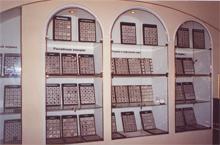
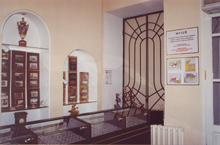
Museum collection includes over 2,5 thousand coins and other relics belonging to different historical epochs: Antique, Medieval, to new and newest time including the period of independent development of the Ukrainian state.
The results of Museum's research activity have been embodied in the regular periodical "Bulletin of the Odessa Museum of Numismatics ". In its issues are published unique and rare coins with analysis of their features (typology, semantics of images, chronology etc.) synthesized with historical events, condition of economy and worldview of that time when coins were minted.
www.museum.com.ua/en/o_musee/ab_mus.htm
